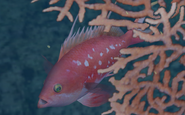← Stocky AnthiasEndless Ocean Creatures
Endless Ocean 2 CreaturesS.O.L Cardinalfish →
Sunset Anthias →
The cherry grouper, or sakuradai (Sacura margaritacea), is a small coral-reef fish that appears in both Endless Ocean and Endless Ocean 2.
Males of the species are a soft pinkish-red color, with pale-pink or white spots scattered across their sides. This pink color gives it the common name "sakuradai", coming from the Japanese word "sakura", which means "cherry blossom". In both games, only male fish are seen.
In-Game[]
Marine Encyclopedia[]
Endless Ocean[]
Description[]
"These fish have narrow, elliptical bodies with vertically elongated dorsal and tail fins. They are generally reed with small white spots on the sides of the body and can be seen year-round in coral reefs and other similar areas.
Females are yellow with a black pattern on their dorsal fins. However, when females undergo sex changes, part of their dorsal fin becomes elongated, their body color changes, and a white blotchy pattern begins to appear.
There is a shiny pattern on the sides of these fish that resembles cherry-blossom petals, and the scientific name reflects this. Sacura means "cherry blossom" in Japanese, and margaritacea means "pearly.""
Endless Ocean 2[]
Description[]
"Red with a white pattern that looks like cherry blossom petals, its scientific name is made up of sakura, meaning "cherry blossom", and margaritacea, meaning "pearly". Females are yellow with a black pattern on their dorsal fins."
Location[]
Endless Ocean[]
Cherry groupers can be found most commonly in rocky, coral-dense areas. They are easiest to find in Rock Bluff, and are found living near the fan corals that cling to the walls.
Endless Ocean 2[]
These fish can be seen all over Gatama Atoll.
Behavior[]
In both games, these fish are seen only under zoom-mode glows and react positively to being given food. They can be seen alone or with other small fish, like juvenile clown triggerfish.
Gallery[]
Notes[]
Real-Life Information[]
- Both games report that the scientific name comes from the words "sakura" (which is Japanese for "cherry blossom") and "margaritacea" (which means "pearly"). This much is true - the genus name Sacura comes from the word "sakura", and the specific name margaritacea is Greek in origin with Latin influence and means "pearl"[1][2].
- The descriptions in both games are also accurate in their report that female fish are yellow with a black pattern on their dorsal fins[1][3]. They are also accurate in their report of the fact that these fish can change sex[4][5][6]. This is a trait called "protogynous hermaphroditism" (pronounced pro-TAW-jeh-nuss her-MA-fro-dye-tiz-m), which means "female first"[7][8].
- The cherry grouper lives at deeper levels than a good deal of reef fish, staying more than 50 feet (15 meters) below the surface[9][10]. Hence, it can tolerate a wider range of temperatures than many others can[11]. Fishkeepers have reported that it is very hardy, able to withstand a range of conditions including temperatures - which it owes to its natural habitat[7].
- While it is sometimes seen in aquariums, the cherry grouper isn't a common tank fish, considering that it originates in Japan and shipping costs are high[12][13].
- In either games, it is frequently found above these depths, which makes its portrayal somewhat inaccurate. For instance, Gatama Atoll, where the cherry grouper lives in Blue World, only ever goes below 50 feet deep at Blue Cliff, the closest to which is Spring Garden at about 45 feet (14 meters) - and the cherry grouper is not found on the side of Blue Cliff.
- Aside from cherry grouper and sakuradai, the cherry grouper is also called the cherry blossom basslet, the sakura anthias, and the cherry anthias[5][7][11].
[]
False Clown Anemonefish
• Yellowtail Clownfish
• Tomato Clownfish
• Yellow Clownfish
Sapphire Devil
• Starck's Demoiselle
• Goldtail Demoiselle
• Blue-Green Chromis
Threespot Dascyllus
• John Dory
• Singular Bannerfish
• Bicolor Angelfish
• Royal Angelfish
Threadfin Butterflyfish
• Bluelashed Butterflyfish
• Black Pyramid Butterflyfish
• Banded Angelfish
Humpback Grouper
• Dusky Batfish
• Mandarinfish
• Goldeye Rockfish
• Marine Betta
Harlequin Sweetlips
• Marbled Flounder
• Yatabei Blenny
• Rippled Rockskipper
• Red-Spotted Blenny
Bicolor Blenny
• Fire Goby
• Elegant Firefish
• Monster Shrimp Goby
• Watchman Goby
Singapore Prawn-Goby
• Blue-Spotted Jawfish
• Peacock Blenny
• Oblong Goby
• Yellow Clown Goby
Red-Spotted Goby
• Five-Lined Coral Goby
• Long-Spine Porcupinefish
• Yellow Boxfish
Whitespotted Boxfish
• Tiger Puffer
• Striated Frogfish
• Painted Frogfish
• Warty Frogfish
• Sea Robin
Southern Orange-Lined Cardinalfish
• Cardinal Fish
• Sea Goldie
• Stocky Anthias
• Cherry Grouper
Sunset Anthias
• Flying Fish
• Chub Mackerel
• Japanese Jack Mackerel
• Japanese Sardine
Antarctic Silverfish
• Capelin
• Dusky Rockcod
• Bald Notothen
• Slender Bristlemouth
References[]
- ↑ 1.0 1.1 Monaco Nature Encyclopedia
- ↑ Quality Marine
- ↑ "A Revision of the Anthiine Fish Genus Sacura (Perciformes: Serranidae) with Descriptions of Two New Species"; Phillip C. Heemstra and John E. Randall
- ↑ Churaumi Fish Encyclopedia
- ↑ 5.0 5.1 ReefApp
- ↑ "Sex Reversal in the Serranid Fish, Sacura margaritacea"; Yo K. Okada
- ↑ 7.0 7.1 7.2 Reefs.com
- ↑ Encyclopaedia Britannica (Fish Reproduction)
- ↑ Marine Life Photography
- ↑ FishBase
- ↑ 11.0 11.1 LiveAquaria
- ↑ Among the Reef
- ↑ Reefs.com (Cherry Grouper Info)











